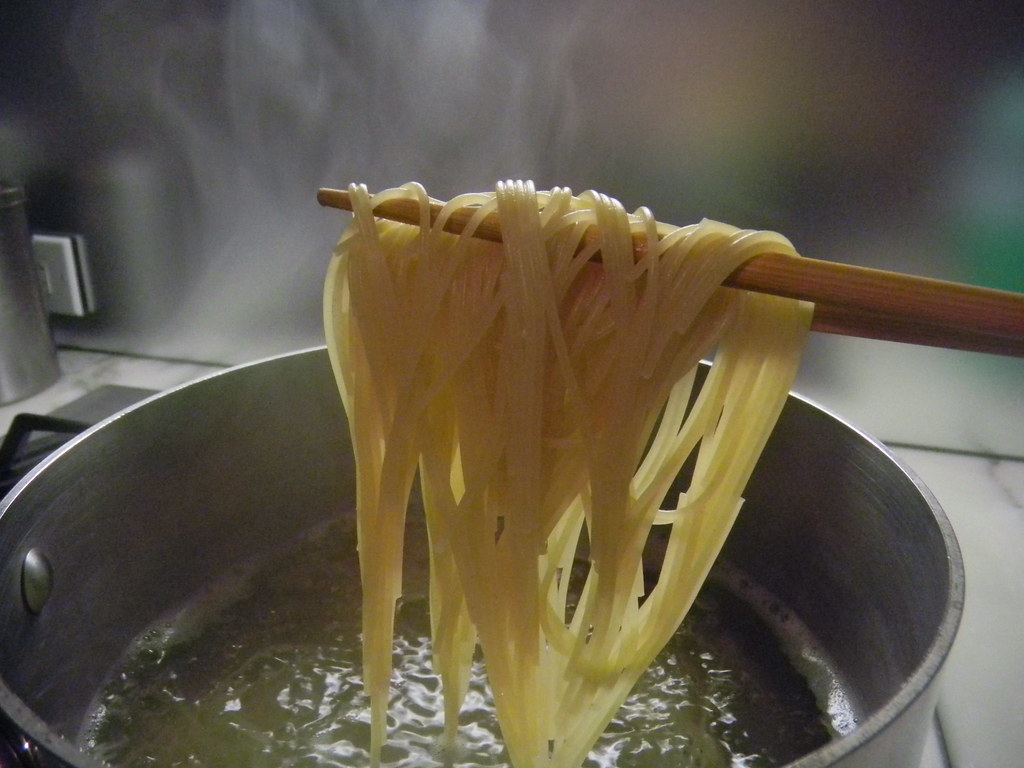
Ramen, as some of my fellow writers have observed, is totally taking over North America. People are obsessively eating, finding new shops, and eating more. New chains from Japan are opening like once a month here in New York City.
Funny thing about ramen is it used to be really difficult to find recipes, but thanks to the internet and this ramen boom, I can find recipes even in English. Ramen is America's new sushi.
Even though you can make ramen from scratch at home, it takes forever to make the stock, and you need access to various bones. Sure, chicken carcass isn't too hard to find, but pork bone is a bit more difficult. Plus it's always challenging to make the noodle, because you need
kansui to make it yellow, which also gives it its elasticity. What is
kansui? Here is explanation on Wiki.
Most noodles are made from four basic ingredients: wheat flour, salt, water, and kansui, which is essentially a type of alkaline mineral water, containing sodium carbonate and usually potassium carbonate, as well as sometimes a small amount of phosphoric acid. Originally, kansui was named after the water from Inner Mongolia's Lake Kan which contained large amounts of these minerals and was said to be perfect for making these noodles. Making noodles with kansui lends them a yellowish hue as well as a firm texture. For a brief time after World War II, low-quality tainted kansui was sold, though kansui is now manufactured according to JAS standards. Eggs may also be substituted for kansui.
I heard some Chinese grocery stores sell them, but noodle-making is always a task. I do have a
pasta-maker, which will ease this process quite a bit, but still, after spending hours simmering the soup base, it's too much of a bother.
One day I was Googling around for new methods, and I came across something very interesting: adding baking soda while cooking pasta supposedly turns it into ramen noodles. WTF?! I was so intrigued, and tried it for myself. It's AMAZING.

Spaghetti is a bit too thick, so cappellini is the best choice here.

Package directs you to cook it for four minutes for al dente pasta.
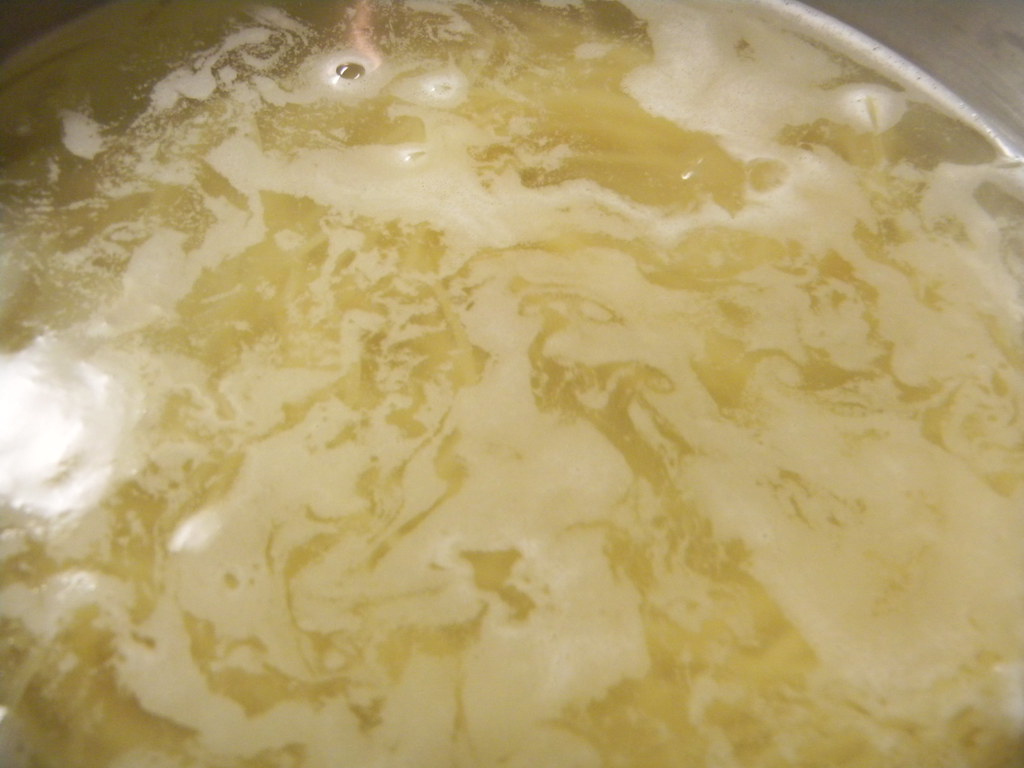
After 2 minutes or so, it's still pasta.

The original Pasta de Ramen recipe post (on
Cookpad from Japan) said to add baking soda after 4 minutes, but I was too impatient and added a table spoon of it at 3.5 minutes.
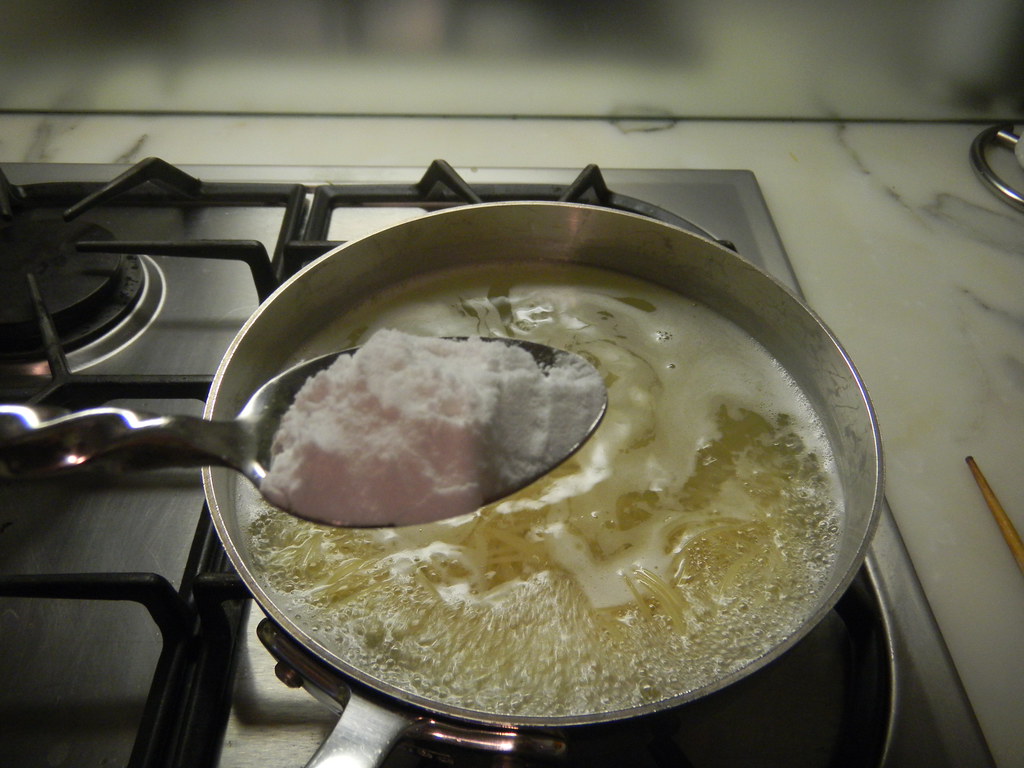
Baking soda ratio: if you are making a box full of pasta, I would add 5 tablespoons of baking soda. Think 1 tablespoon per serving.
Holy bubble! VERY IMPORTANT thing to remember is to use a big enough pot so that you can avoid a mess on your stove.
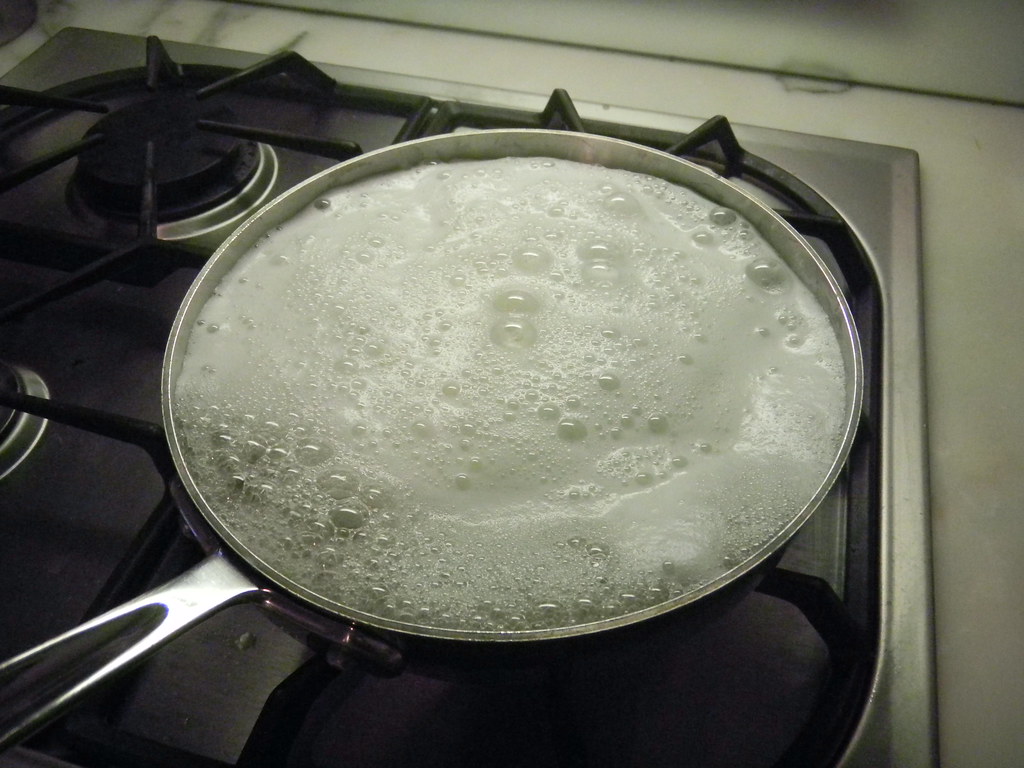
Cook for an additional 2 minutes. Boom, something in the cooking liquid turned regular pasta into ramen noodle!!
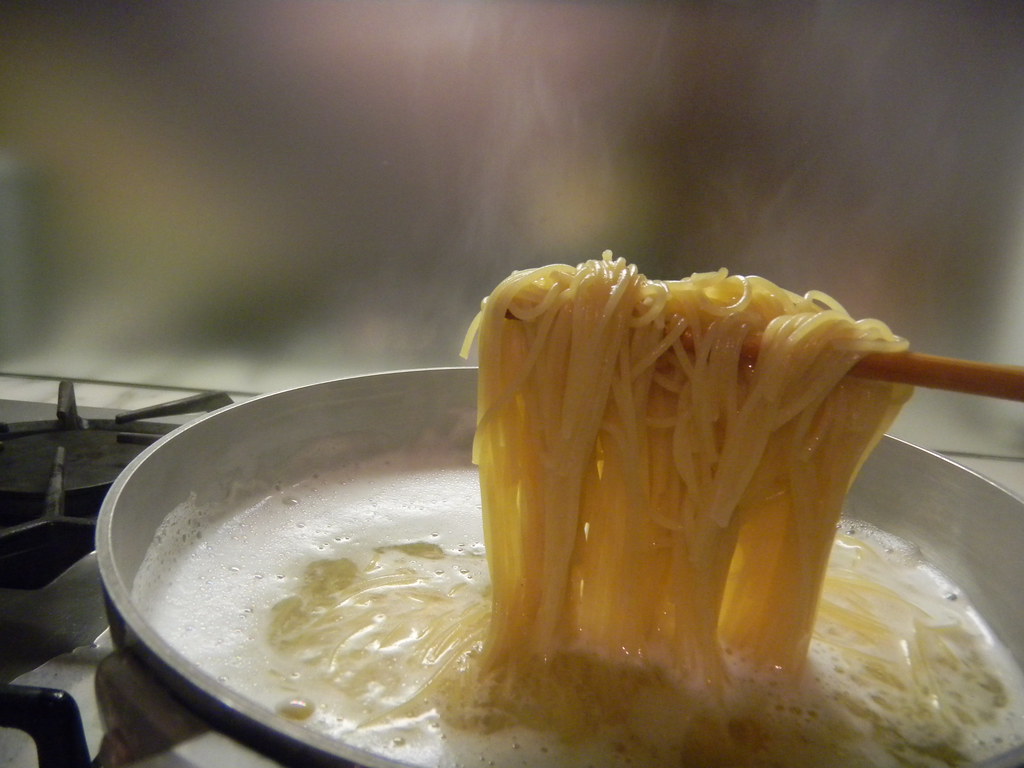
You HAVE to try this, because it starts to smell like cooking ramen noodles as well. The color also changes, turning a darker yellow, which is just like ramen noodles.
Can you see it's a bit more sticky than regular pasta?
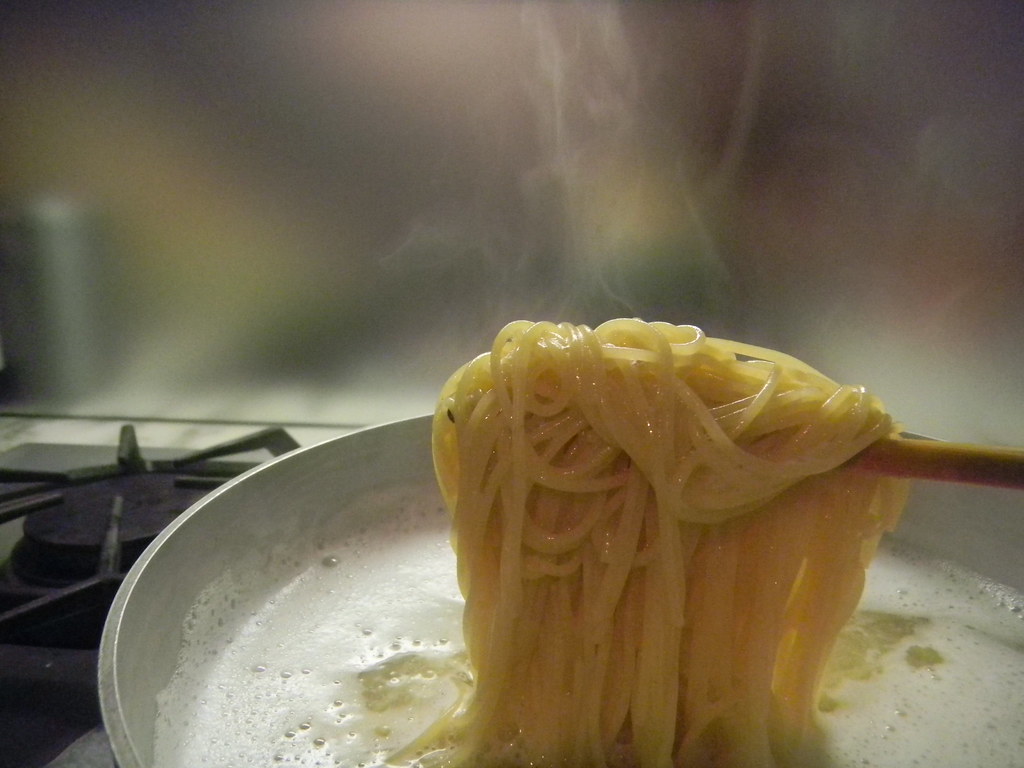
Doesn't this look like ramen noodles?
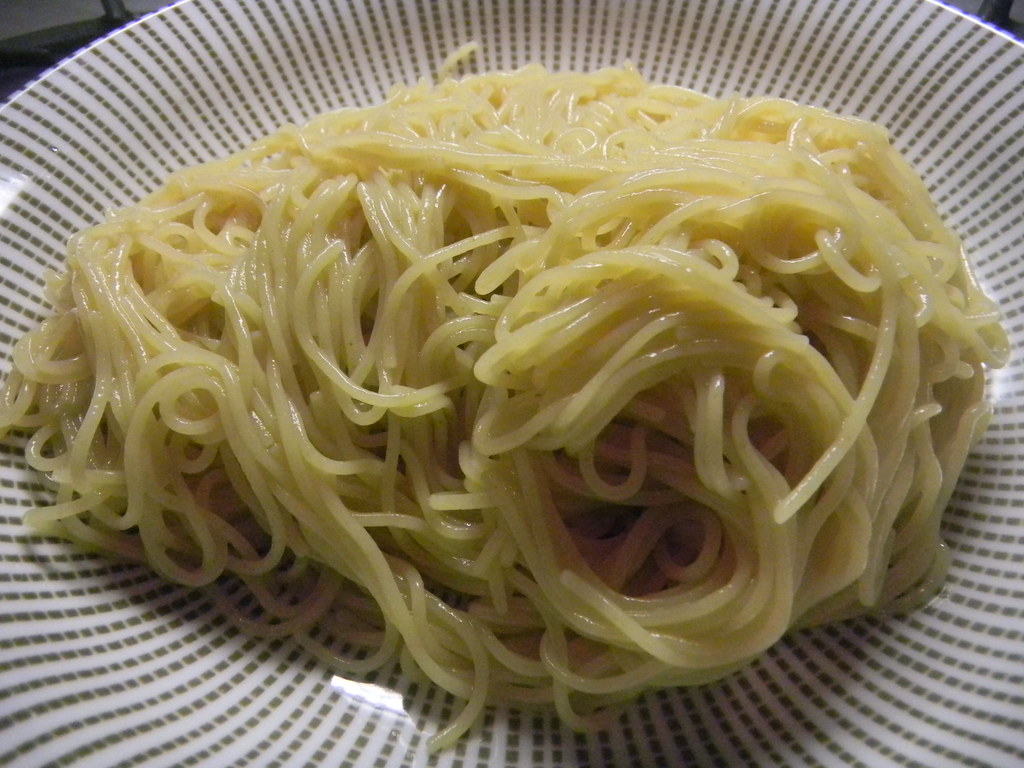
Just to give you an idea, this is regular pasta. The color is definitely very different.
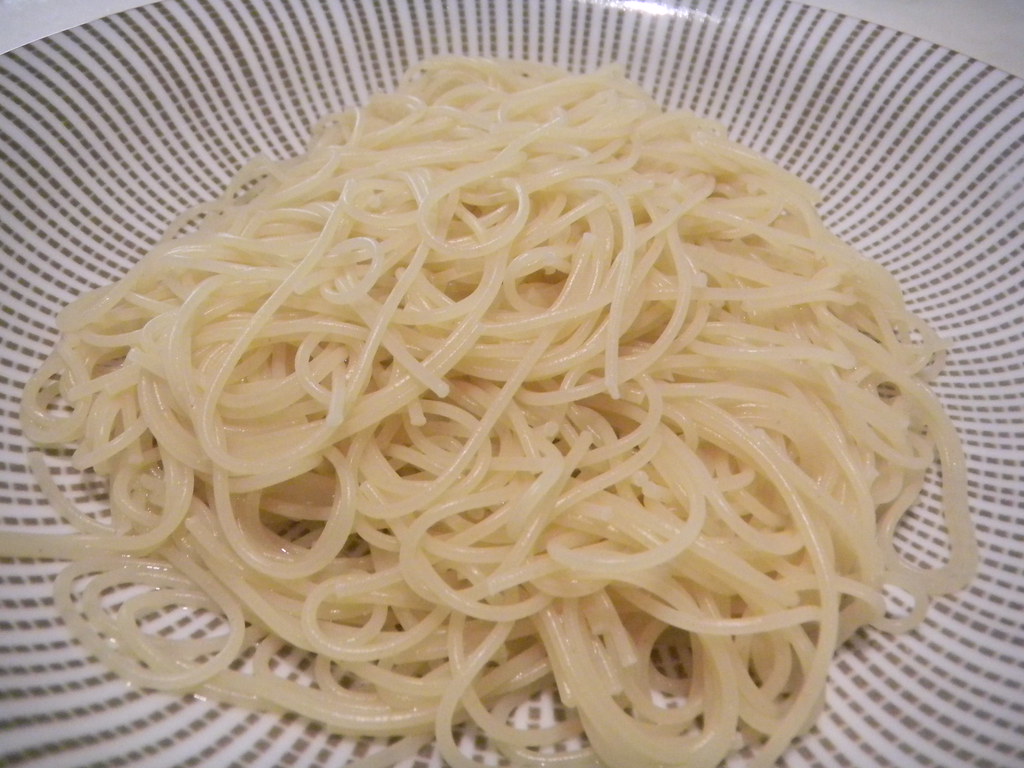
I made yakisoba with the noodles. It gets very sticky, so I rinsed it with water once, then made the yakisoba. This was actually better than using packaged yakisoba or ramen noodles since it didn't get soggy at all.
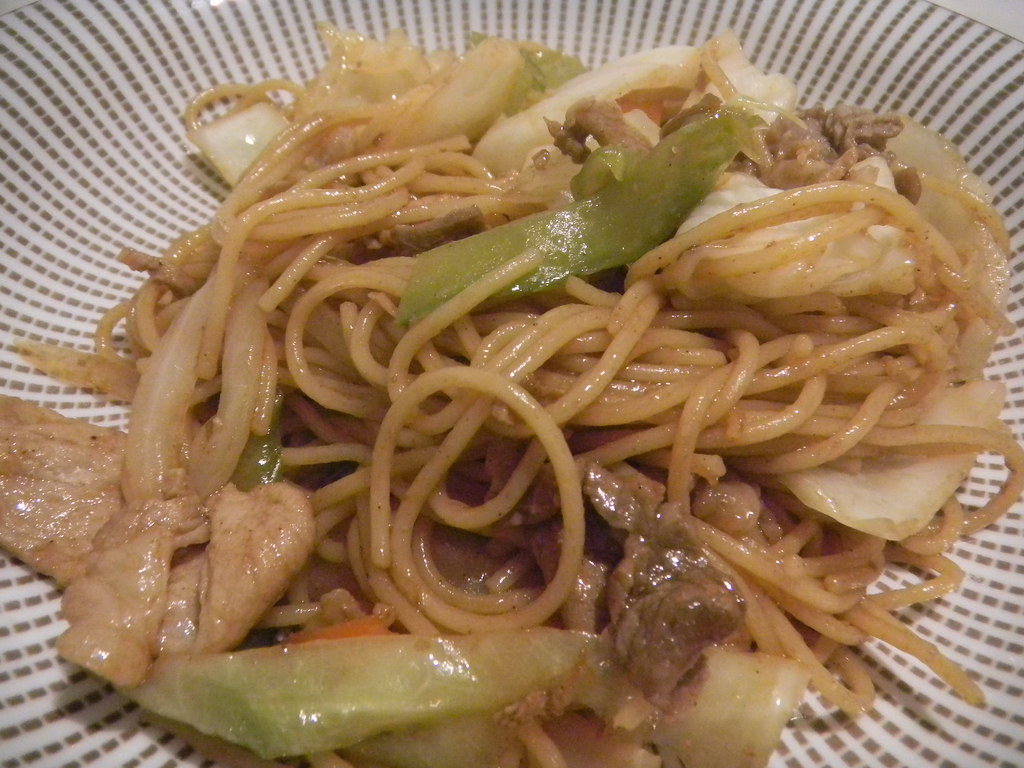
Yep, the stove is a mess.
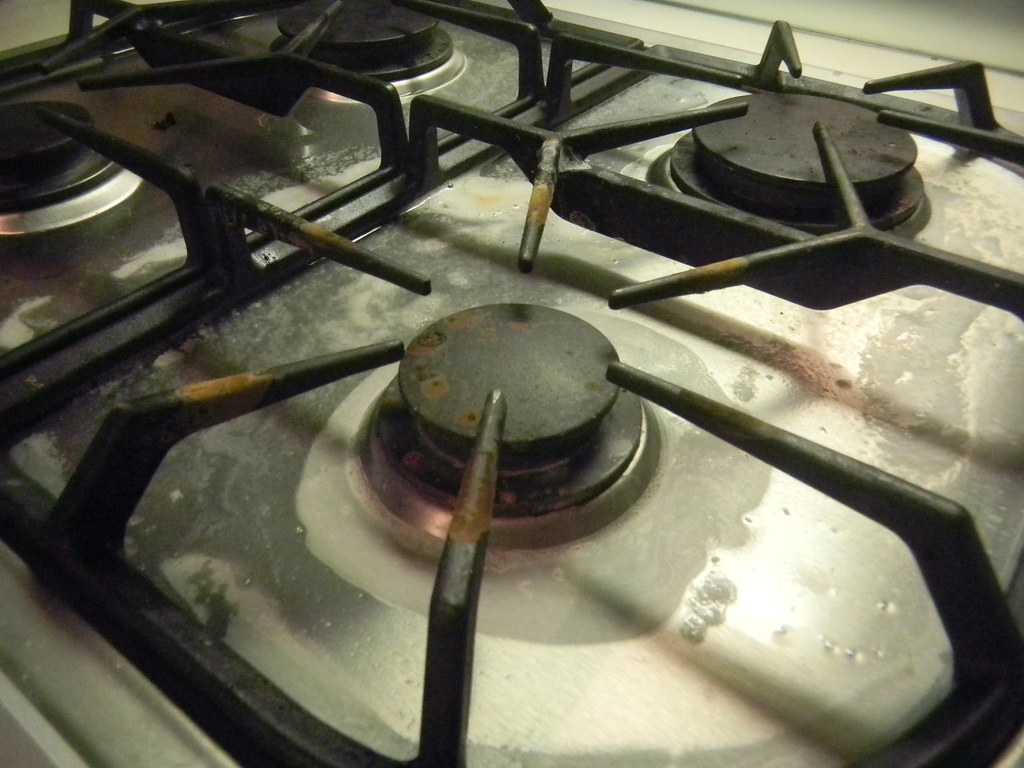
Scientifically,
kansui is Na2CO3 and baking soda is NaHCO3. I have no idea what this means, but apparently by adding baking soda, it acts as the
kansui, and turns pasta into ramen noodle.
I am not saying this is the best, but for amateur cooking at home, this totally is a GREAT method, especially things like
hiyashi-chuka (cold ramen) And it's definitely cheaper than the packaged noodles.
Please try this for yourself, so we can share the jaw-dropping moment of "Holy shit, it smells like ramen!" just around minute 4:30. When you buy the cheap ramen noodle packets, why don't you leave the noodles, and make Pasta de Ramen instead, with the soup powder? I always gets grossed out eating cheap instant ramen since the noodles are fried, but this method will totally kick things up a notch!! Sure you need two pots, and it beats the "instant" element (plus you will be probably too drunk to care), but this will make a gourmet instant ramen.
Wouldn't it be weird/fun to find penne in ramen soup that tastes just like ramen?
 Ramen, as some of my fellow writers have observed, is totally taking over North America. People are obsessively eating, finding new shops, and eating more. New chains from Japan are opening like once a month here in New York City.
Funny thing about ramen is it used to be really difficult to find recipes, but thanks to the internet and this ramen boom, I can find recipes even in English. Ramen is America's new sushi.
Even though you can make ramen from scratch at home, it takes forever to make the stock, and you need access to various bones. Sure, chicken carcass isn't too hard to find, but pork bone is a bit more difficult. Plus it's always challenging to make the noodle, because you need kansui to make it yellow, which also gives it its elasticity. What is kansui? Here is explanation on Wiki.
Most noodles are made from four basic ingredients: wheat flour, salt, water, and kansui, which is essentially a type of alkaline mineral water, containing sodium carbonate and usually potassium carbonate, as well as sometimes a small amount of phosphoric acid. Originally, kansui was named after the water from Inner Mongolia's Lake Kan which contained large amounts of these minerals and was said to be perfect for making these noodles. Making noodles with kansui lends them a yellowish hue as well as a firm texture. For a brief time after World War II, low-quality tainted kansui was sold, though kansui is now manufactured according to JAS standards. Eggs may also be substituted for kansui.
I heard some Chinese grocery stores sell them, but noodle-making is always a task. I do have a pasta-maker, which will ease this process quite a bit, but still, after spending hours simmering the soup base, it's too much of a bother.
One day I was Googling around for new methods, and I came across something very interesting: adding baking soda while cooking pasta supposedly turns it into ramen noodles. WTF?! I was so intrigued, and tried it for myself. It's AMAZING.
Ramen, as some of my fellow writers have observed, is totally taking over North America. People are obsessively eating, finding new shops, and eating more. New chains from Japan are opening like once a month here in New York City.
Funny thing about ramen is it used to be really difficult to find recipes, but thanks to the internet and this ramen boom, I can find recipes even in English. Ramen is America's new sushi.
Even though you can make ramen from scratch at home, it takes forever to make the stock, and you need access to various bones. Sure, chicken carcass isn't too hard to find, but pork bone is a bit more difficult. Plus it's always challenging to make the noodle, because you need kansui to make it yellow, which also gives it its elasticity. What is kansui? Here is explanation on Wiki.
Most noodles are made from four basic ingredients: wheat flour, salt, water, and kansui, which is essentially a type of alkaline mineral water, containing sodium carbonate and usually potassium carbonate, as well as sometimes a small amount of phosphoric acid. Originally, kansui was named after the water from Inner Mongolia's Lake Kan which contained large amounts of these minerals and was said to be perfect for making these noodles. Making noodles with kansui lends them a yellowish hue as well as a firm texture. For a brief time after World War II, low-quality tainted kansui was sold, though kansui is now manufactured according to JAS standards. Eggs may also be substituted for kansui.
I heard some Chinese grocery stores sell them, but noodle-making is always a task. I do have a pasta-maker, which will ease this process quite a bit, but still, after spending hours simmering the soup base, it's too much of a bother.
One day I was Googling around for new methods, and I came across something very interesting: adding baking soda while cooking pasta supposedly turns it into ramen noodles. WTF?! I was so intrigued, and tried it for myself. It's AMAZING.
 Spaghetti is a bit too thick, so cappellini is the best choice here.
Spaghetti is a bit too thick, so cappellini is the best choice here.
 Package directs you to cook it for four minutes for al dente pasta.
Package directs you to cook it for four minutes for al dente pasta.
 After 2 minutes or so, it's still pasta.
After 2 minutes or so, it's still pasta.
 The original Pasta de Ramen recipe post (on Cookpad from Japan) said to add baking soda after 4 minutes, but I was too impatient and added a table spoon of it at 3.5 minutes.
The original Pasta de Ramen recipe post (on Cookpad from Japan) said to add baking soda after 4 minutes, but I was too impatient and added a table spoon of it at 3.5 minutes.
 Baking soda ratio: if you are making a box full of pasta, I would add 5 tablespoons of baking soda. Think 1 tablespoon per serving.
Holy bubble! VERY IMPORTANT thing to remember is to use a big enough pot so that you can avoid a mess on your stove.
Baking soda ratio: if you are making a box full of pasta, I would add 5 tablespoons of baking soda. Think 1 tablespoon per serving.
Holy bubble! VERY IMPORTANT thing to remember is to use a big enough pot so that you can avoid a mess on your stove.
 Cook for an additional 2 minutes. Boom, something in the cooking liquid turned regular pasta into ramen noodle!!
Cook for an additional 2 minutes. Boom, something in the cooking liquid turned regular pasta into ramen noodle!!
 You HAVE to try this, because it starts to smell like cooking ramen noodles as well. The color also changes, turning a darker yellow, which is just like ramen noodles.
Can you see it's a bit more sticky than regular pasta?
You HAVE to try this, because it starts to smell like cooking ramen noodles as well. The color also changes, turning a darker yellow, which is just like ramen noodles.
Can you see it's a bit more sticky than regular pasta?
 Doesn't this look like ramen noodles?
Doesn't this look like ramen noodles?
 Just to give you an idea, this is regular pasta. The color is definitely very different.
Just to give you an idea, this is regular pasta. The color is definitely very different.
 I made yakisoba with the noodles. It gets very sticky, so I rinsed it with water once, then made the yakisoba. This was actually better than using packaged yakisoba or ramen noodles since it didn't get soggy at all.
I made yakisoba with the noodles. It gets very sticky, so I rinsed it with water once, then made the yakisoba. This was actually better than using packaged yakisoba or ramen noodles since it didn't get soggy at all.
 Yep, the stove is a mess.
Yep, the stove is a mess.
 Scientifically, kansui is Na2CO3 and baking soda is NaHCO3. I have no idea what this means, but apparently by adding baking soda, it acts as the kansui, and turns pasta into ramen noodle.
I am not saying this is the best, but for amateur cooking at home, this totally is a GREAT method, especially things like hiyashi-chuka (cold ramen) And it's definitely cheaper than the packaged noodles.
Please try this for yourself, so we can share the jaw-dropping moment of "Holy shit, it smells like ramen!" just around minute 4:30. When you buy the cheap ramen noodle packets, why don't you leave the noodles, and make Pasta de Ramen instead, with the soup powder? I always gets grossed out eating cheap instant ramen since the noodles are fried, but this method will totally kick things up a notch!! Sure you need two pots, and it beats the "instant" element (plus you will be probably too drunk to care), but this will make a gourmet instant ramen.
Wouldn't it be weird/fun to find penne in ramen soup that tastes just like ramen?
Scientifically, kansui is Na2CO3 and baking soda is NaHCO3. I have no idea what this means, but apparently by adding baking soda, it acts as the kansui, and turns pasta into ramen noodle.
I am not saying this is the best, but for amateur cooking at home, this totally is a GREAT method, especially things like hiyashi-chuka (cold ramen) And it's definitely cheaper than the packaged noodles.
Please try this for yourself, so we can share the jaw-dropping moment of "Holy shit, it smells like ramen!" just around minute 4:30. When you buy the cheap ramen noodle packets, why don't you leave the noodles, and make Pasta de Ramen instead, with the soup powder? I always gets grossed out eating cheap instant ramen since the noodles are fried, but this method will totally kick things up a notch!! Sure you need two pots, and it beats the "instant" element (plus you will be probably too drunk to care), but this will make a gourmet instant ramen.
Wouldn't it be weird/fun to find penne in ramen soup that tastes just like ramen?




Comments (11)
Oh, I forgot to mention the ratio. If you are making a box full of pasta, I would put 5 tbsp of baking soda. Think 1tbsp baking soda per serving.
The yakisoba looks so good. Wow, it’s mind boggling to see it change so quickly. The picture of your stovetop reminds me to clean mine too.
Holy Moly! This is a neat little trick. Thanks for posting this. Now that you got me this far with the noodles, let me know if there’s a simple version of ramen broth I can do at home.
yes!!! this reminds me of the alkaline noodle recipe in lucky peach, but i guess i didn’t realize you could just do that with regular old pasketti noodles. thank you for making a mess on your stove so i don’t have to! :-D
Here’s the deal: if obsessing about the broth means that you lose heart not the noodle and go for a ergatz-spaghetti type ramen noodle…I wonder what the point of it all is.
Just make a good broth period. Make good noodles period.
Add toppings.
Don’t obsess.
I usually just make broth with maybe half the packet of ramen seasoning and then add some aromatics and let it simmer for a while. it comes out very tasty and it’s very easy to do.
I made a ramen soup with this today, and it was so good. I’m vegan and have a hard time finding suitable ramen, so I love this! You rock!
Re: “Scientifically, kansui is Na2CO3 and baking soda is NaHCO3. I have no idea what this means, but apparently by adding baking soda, it acts as the kansui, and turns pasta into ramen noodle.”
Thanks for the yummy info! I thought I’d contribute a little because we really enjoy your recipes. My education was in biochemistry and want to point out that one can easily make food grade kansui you mentioned (Na2CO3, sodium carbonate, also called washing soda) by baking food grade baking soda (NaHCO3, sodium bicarbonate) in an oven.
Spread a few cups of food grade baking soda (sodium bicarbonate, NaHCO3) on a cookie sheet and heat in an oven at 300°F for one hour to drive off water and carbon dioxide. This will transform it into sodium carbonate, Na2CO3. Overheating or baking for longer is not a problem. Store it in an airtight container so it doesn’t absorb water and CO2 from the air which causes it revert back to bicarbonate.
Since sodium carbonate is a lot more basic than sodium bicarbonate (higher pH), much less is required to make the noodles, and it will work/taste better. Email me if you have further chemistry questions. Good luck and thank you for sharing your recipes! :)
Biochemistfoodie, this is one of the best feedbacks I’ve received. I bought kansui in Japan a couple of years ago, but can’t find it (probably will find it in a couple of years), and I am thinking about making ramen (soup, noodle, everything from scratch). I will definitely make my own kansui using your recipe. The only concern is carbon dioxide. Should I stay out of kitchen (I luckily have a window right next to the stove, so should I leave it open while cooking baking soda?) ? Or is it a very low level CD that I shouldn’t worry about?
You’re very welcome, glad to be of help. Baking the sodium bicarbonate isn’t hazardous, it won’t produce more carbon dioxide than having a few guests over for dinner, so no need to worry. Have fun and pls post how it works for your ramen. I have young kids, and they love it!